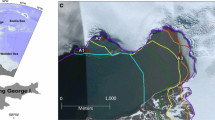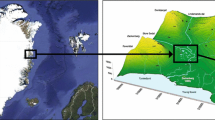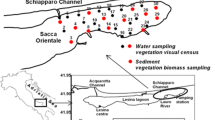Abstract
Photochemical activity of phytobenthic communities in two freshwater lakes in East Antarctica was estimated using a submersible pulse-amplitude modulation (PAM) chlorophyll fluorometer, to answer the following questions: (1) Are the communities under bright summer photosynthetically active radiation (PAR) photosynthetically active? (2) If active, which community shows the most active signals? (3) Where is the most productive part (or depth) in the lake? Our limnological measurements indicated the two lakes were ultra-oligotrophic. Diving observations revealed that the phytobenthos of the lakes was moss-dominated which had different life-forms (moss shoots in shallow depths of both lakes, moss-pillars in the shallow lake, pinnacle moss-microbial complex community in the deeper lake). In addition, various mat-forming microbial communities inhabited the lake beds. In situ measurements of photochemical parameters indicated that shoots of mosses living just below the littoral slope, and the apical part of the moss pillars, had the highest photosynthetic activity in open water summer conditions, but mat-forming microbial communities and the other moss-microbial complex communities, showed rather lower activity. Most of the mat-forming phytobenthos surface also showed positive photosynthetic activity, but there were some cases of negligible signals in the shallow depth. This suggests that the photosynthetic activities of mat-forming communities in the shallow water were suppressed by strong ambient light in summer.







Similar content being viewed by others
References
Dana GL, Wharton RA, Dubayah R (1998) Solar radiation in the McMurdo Dry Valleys, Antarctica. In: Priscu JC (ed) Ecosystem dynamics in a polar desert: The McMurdo Dry Valleys, Antarctica. Antarctic Research Series 72. American Geophysical Union, Washington, DC, pp 39–64
Ehling-Schulz M, Bilger W, Scherer AS (1997) UV-B-induced synthesis of photoprotective pigments and extracellular polysaccharides in the terrestrial cyanobacterium Nostoc commune. J Bacteriol 179:940–945
Goldman CR, Mason DT, Wood BJB (1963) Light injury and inhibition in Antarctic freshwater phytoplankton. Limnol Oceanogr 8:313–322
Hodgson DA, Vyverman W, Verleyen E, Sabbe K, Leavitt PR, Taton A, Squier AH, Keely BJ (2004) Environmental factors influencing the pigment composition of in situ benthic microbial communities in east Antarctic lakes. Aquat Microb Ecol 37:247–263. doi:10.3354/ame037247
Imura S, Bando T, Saito S, Seto K, Kanda H (1999) Benthic moss pillars in Antarctic lakes. Polar Biol 22:137–140. doi:10.1007/s003000050401
Imura S, Bando T, Seto K, Ohtani S, Kudoh S, Kanda H (2003) Distribution of aquatic mosses in Sôya Coast region, East Antarctica. Polar Biosci 16:1–10
Kanda H, Iwatsuki Z (1989) Two aquatic mosses in the lakes near Syowa Stations, Continental Antarctica. Hikobia 10:293–297
Kanda H, Ohtani S (1991) Morphology of the aquatic mosses collected in Lake Yukidori, Langhovde, Antarctica. Proc NIPR Symp Polar Biol 4:114–122
Kudoh S, Tuchiya Y, Ayukawa E, Imura S, Kanda H (2003a) Ecological studies of aquatic moss pillars in Antarctic lakes. 1: macro structure and carbon, nitrogen and chlorophyll a contents. Polar Biosci 16:11–22
Kudoh S, Watanabe K, Imura S (2003b) Ecological studies of aquatic moss pillars in Antarctic lakes. 2: temperature and light environment at the moss habitat. Polar Biosci 16:23–32
Kudoh S, Kashino Y, Imura S (2003c) Ecological studies of aquatic moss pillars in Antarctic lakes. 3: light response and chilling and heat sensitivity of photosynthesis. Polar Biosci 16:33–42
Lizotte MP (2008) Phytoplankton and primary production. In: Vincent WF, Laybourn-Parry J (eds) Polar lakes and rivers. Oxford University Press, Oxford, pp 157–178
Matsumoto GI, Komori K, Enomoto A, Imura S, Takemura T, Ohyama Y, Kanda H (2006) Environmental changes in Syowa Station area of Antarctica during the last 2,300 years inferred from organic components in lake sediment cores. Polar Biosci 19:51–62
McMinn A, Hegseth EN (2004) Quantum yield and photosynthetic parameters of marine microalgae from the southern Arctic ocean, Svalbard. J Mar Biol Assoc UK 84:865–871. doi:10.1017/S0025315404010112h
Miura H, Maemoku H, Igarashi A, Moriwaki K (1998) Special map series of National Institute of Polar Research No. 6. National Institute of Polar Research, Tokyo, 46 pp
Miura H, Maemoku H, Yoshinaga S, Takeda M, Zwartz D (2002) Holocene event in coastal regions of Antarctica: upheaval of coastal topography and abandonment of penguin rookery. Gekkan Chikyu 24:23–30 in Japanese
Montecino V, Pizarro G, Cabrera S, Contreras M (1991) Spatial and temporal photosynthetic compartment during summer in Antarctic Lake Kitiesh. Polar Biol 11:317–377. doi:10.1007/BF00239689
Moran R, Porath D (1980) Chlorophyll determination in intact tissues using N,N-dimethylformamide. Plant Physiol 65:478–479
Mueller DR, Vincent WF, Bonilla S, Laurion I (2005) Extremotrophs, extremophiles and broadband pigmentation strategies in a high arctic ice shelf ecosystem. FEMS Microbiol Ecol 53:73–87. doi:10.1016/j.femsec.2004.11.001
Murayama H (1977) General characteristics of the Antarctic lakes near Syowa Station. Antarct Rec (Tokyo) 58:43–62 in Japanese with English abstract
Neale PJ, Priscu JC (1995) The photosynthetic apparatus of phytoplankton from a perennially ice-covered Antarctic lake: acclimation to an extreme shade environment. Plant Cell Physiol 36:253–263
Ohtsuka T, Kudoh S, Imura S, Ohtani S (2006) Diatom composing benthic microbial mats in freshwater lakes of Skarvsnes ice-free area, East Antarctica. Polar Biosci 20:113–130
Priddle J (1980) The production ecology of benthic plants in some Antarctic lakes. 1: in situ production studies. J Ecol 68:141–153. doi:10.2307/2259248
Priddle J, Dartnall HJG (1978) Biology of an Antarctic aquatic moss community. Freshw Biol 8:469–480. doi:10.1111/j.1365-2427.1978.tb01469.x
Quesada A, Vincent WF (1997) Strategies of adaptation by Antarctic cyanobacteria to ultraviolet radiation. Eur J Phycol 32:335–342. doi:10.1017/S0967026297001431
Quesada A, Vincent WF, Lean DRS (1999) Community and pigment structure of Arctic cyanobacterial assemblages: the occurrence and distribution of UV-absorbing compounds. FEMS Microbiol Ecol 28:315–323. doi:10.1111/j.1574-6941.1999.tb00586.x
Quesada A, Fernandez-Valiente E, Hawes I, Howard-Williams C (2008) Benthic primary production in polar lakes and rivers. In: Vincent WF, Laybourn-Parry J (eds) Polar lakes and rivers. Oxford University Press, Oxford, pp 179–196
Roos JC, Vincent WF (1998) Temperature dependence of UV radiation effects on Antarctic cyanobacteria. J Phycol 34:118–125. doi:10.1046/j.1529-8817.1998.340118.x
Sabbe K, Hodgson DA, Verleyen E, Taton A, Wilmotte A, Vanhoutte K, Vyverman W (2004) Salinity, depth and the structure and composition of microbial mats in continental Antarctic lakes. Freshw Biol 49:296–319. doi:10.1111/j.1365-2427.2004.01186.x
Schreiber U, Bilger W, Neubauer C (1994) Chlorophyll fluorescence as a nonintrusive indicator for rapid assessment of in vivo photosynthesis. In: Schulze E-D, Caldwell MM (eds) Ecophysiology of photosynthesis, vol 100. Springer, Berlin, pp 49–70
Seto K, Imura S, Bando T, Kanda H (2002) Paleoenvironment of holocene recorded in Antarctic lakes. Gekkan Chikyu 24:31–36 in Japanese
Tanabe Y, Kudoh S, Imura S, Fukuchi M (2008) Phytoplankton blooms under dim and cold conditions in freshwater lakes of East Antarctica. Polar Biol 31:199–208. doi:10.1007/s00300-007-0347-2
Vincent WF (1988) Microbial ecosystems of Antarctica. Cambridge University Press, Cambridge
Vincent WF (2000) Cyanobacterial dominance in the polar regions. In: Whitton BA, Potts M (eds) Ecology of the cyanobacteria: their diversity in space and time. Kluwer Academic Press, Dordrecht, pp 321–340
Vincent WF, Downes MT, Castenholz RW, Howard-Williams C (1993) Community structure and pigment organization of cyanobacteria-dominated microbial mats in Antarctica. Eur J Phycol 28:213–221. doi:10.1080/09670269300650321
Vincent WF, Hobbie JE, Laybourn-Parry J (2008) Introduction to the limnology of high-latitude lake and river ecosystems. In: Vincent WF, Laybourn-Parry J (eds) Polar lakes and rivers. Oxford University Press, Oxford, pp 1–24
Acknowledgments
We gratefully acknowledge the members of the 45th Japanese Antarctic Research Expedition (JARE), especially its leader Dr. H. Kanda and our colleagues of biological field researchers, Dr. K. Sakamoto and Ms. M. Iida for their support in the field and other ways. We also thank to Dr. Yasuhiro Kashino and Dr. Patricia Laura Rodrigues for appropriate advices in revision of our manuscript.
Author information
Authors and Affiliations
Corresponding author
Rights and permissions
About this article
Cite this article
Kudoh, S., Tanabe, Y., Matsuzaki, M. et al. In situ photochemical activity of the phytobenthic communities in two Antarctic lakes. Polar Biol 32, 1617–1627 (2009). https://doi.org/10.1007/s00300-009-0660-z
Received:
Revised:
Accepted:
Published:
Issue Date:
DOI: https://doi.org/10.1007/s00300-009-0660-z




